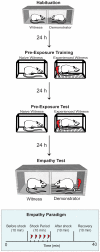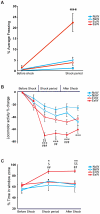Experience modulates vicarious freezing in rats: a model for empathy
- PMID: 21765921
- PMCID: PMC3135600
- DOI: 10.1371/journal.pone.0021855
Experience modulates vicarious freezing in rats: a model for empathy
Abstract
The study of the neural basis of emotional empathy has received a surge of interest in recent years but mostly employing human neuroimaging. A simpler animal model would pave the way for systematic single cell recordings and invasive manipulations of the brain regions implicated in empathy. Recent evidence has been put forward for the existence of empathy in rodents. In this study, we describe a potential model of empathy in female rats, in which we studied interactions between two rats: a witness observes a demonstrator experiencing a series of footshocks. By comparing the reaction of witnesses with or without previous footshock experience, we examine the role of prior experience as a modulator of empathy. We show that witnesses having previously experienced footshocks, but not naïve ones, display vicarious freezing behavior upon witnessing a cage-mate experiencing footshocks. Strikingly, the demonstrator's behavior was in turn modulated by the behavior of the witness: demonstrators froze more following footshocks if their witness froze more. Previous experiments have shown that rats emit ultrasonic vocalizations (USVs) when receiving footshocks. Thus, the role of USV in triggering vicarious freezing in our paradigm is examined. We found that experienced witness-demonstrator pairs emitted more USVs than naïve witness-demonstrator pairs, but the number of USVs was correlated with freezing in demonstrators, not in witnesses. Furthermore, playing back the USVs, recorded from witness-demonstrator pairs during the empathy test, did not induce vicarious freezing behavior in experienced witnesses. Thus, our findings confirm that vicarious freezing can be triggered in rats, and moreover it can be modulated by prior experience. Additionally, our result suggests that vicarious freezing is not triggered by USVs per se and it influences back onto the behavior of the demonstrator that had elicited the vicarious freezing in witnesses, introducing a paradigm to study empathy as a social loop.
Conflict of interest statement
Figures





References
-
- Hutchison WD, Davis KD, Lozano AM, Tasker RR, Dostrovsky JO. Pain-related neurons in the human cingulate cortex. Nat Neurosci. 1999;2:403–405. - PubMed
-
- Wicker B, Keysers C, Plailly J, Royet JP, Gallese V, et al. Both of us disgusted in My insula: the common neural basis of seeing and feeling disgust. Neuron. 2003;40:655–664. - PubMed
-
- Morrison I, Lloyd D, di Pellegrino G, Roberts N. Vicarious responses to pain in anterior cingulate cortex: is empathy a multisensory issue? Cogn Affect Behav Neurosci. 2004;4:270–278. - PubMed
-
- Singer T. Empathy for Pain Involves the Affective but not Sensory Components of Pain. Science. 2004;303:1157–1162. - PubMed
Publication types
MeSH terms
LinkOut - more resources
Full Text Sources

